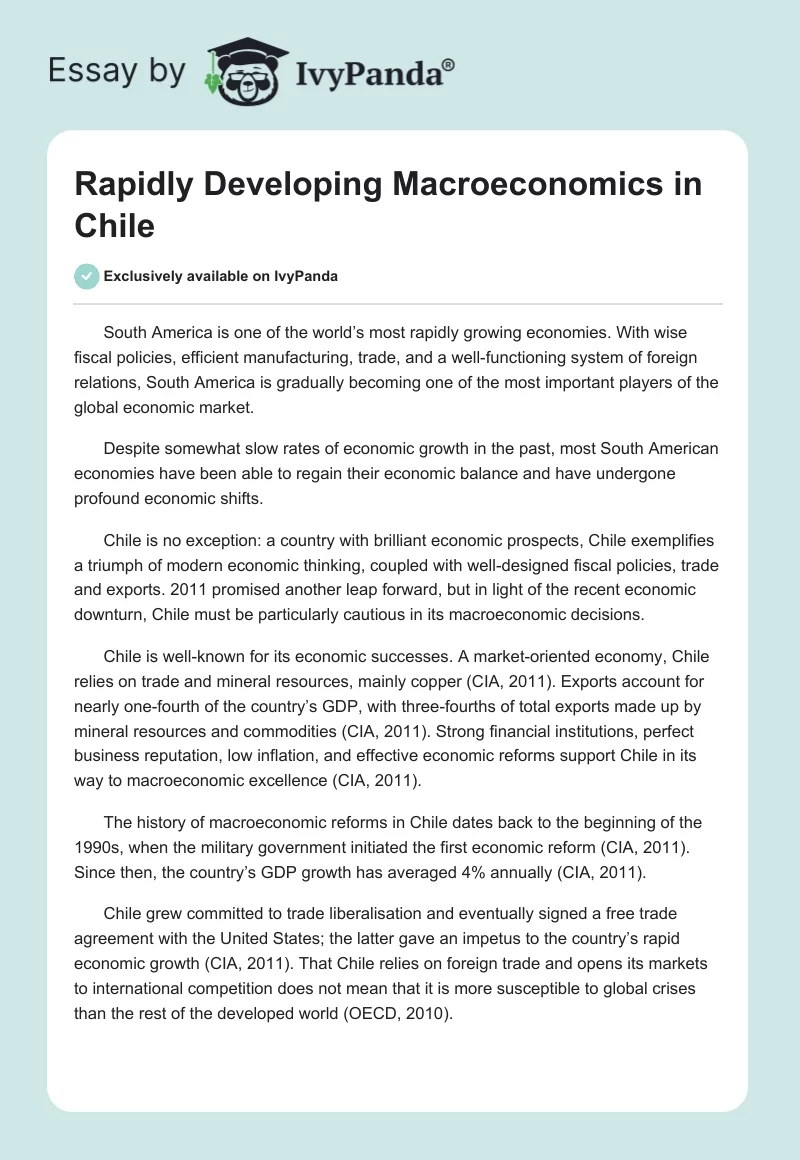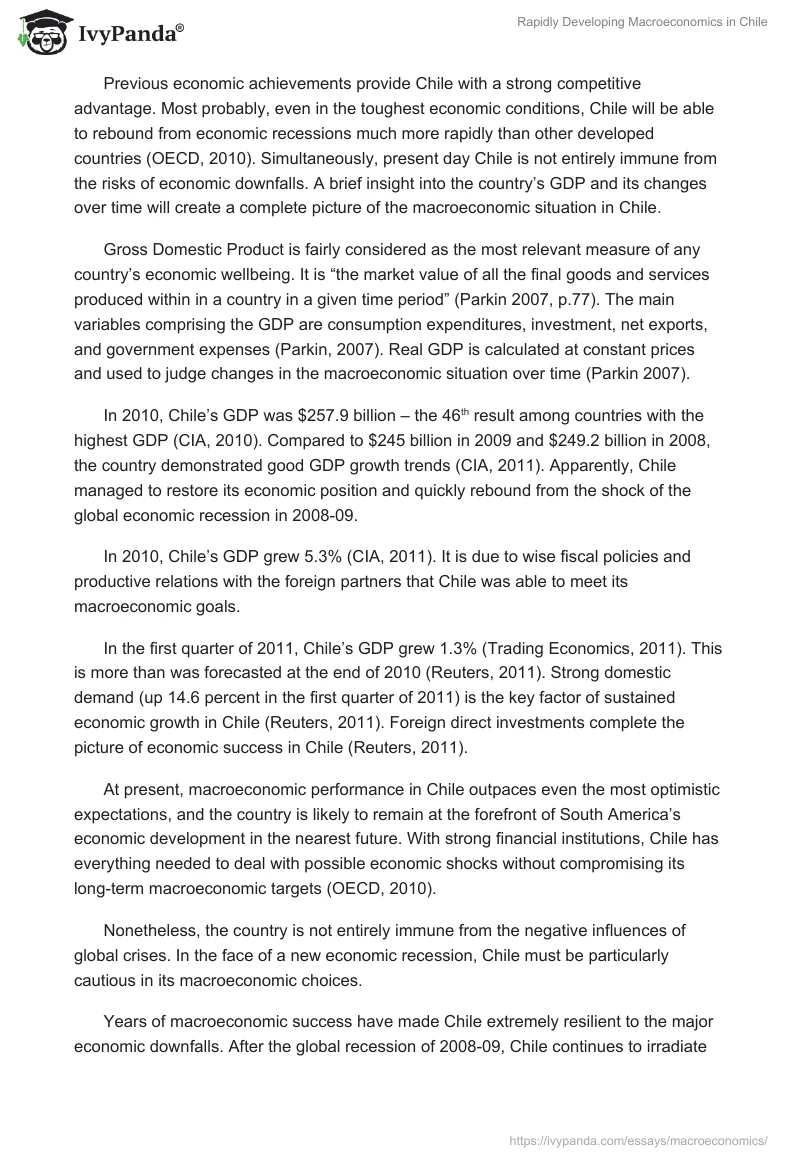South America is one of the world’s most rapidly growing economies. With wise fiscal policies, efficient manufacturing, trade, and a well-functioning system of foreign relations, South America is gradually becoming one of the most important players of the global economic market.
Despite somewhat slow rates of economic growth in the past, most South American economies have been able to regain their economic balance and have undergone profound economic shifts.
Chile is no exception: a country with brilliant economic prospects, Chile exemplifies a triumph of modern economic thinking, coupled with well-designed fiscal policies, trade and exports. 2011 promised another leap forward, but in light of the recent economic downturn, Chile must be particularly cautious in its macroeconomic decisions.
Chile is well-known for its economic successes. A market-oriented economy, Chile relies on trade and mineral resources, mainly copper (CIA, 2011). Exports account for nearly one-fourth of the country’s GDP, with three-fourths of total exports made up by mineral resources and commodities (CIA, 2011). Strong financial institutions, perfect business reputation, low inflation, and effective economic reforms support Chile in its way to macroeconomic excellence (CIA, 2011).
The history of macroeconomic reforms in Chile dates back to the beginning of the 1990s, when the military government initiated the first economic reform (CIA, 2011). Since then, the country’s GDP growth has averaged 4% annually (CIA, 2011).
Chile grew committed to trade liberalisation and eventually signed a free trade agreement with the United States; the latter gave an impetus to the country’s rapid economic growth (CIA, 2011). That Chile relies on foreign trade and opens its markets to international competition does not mean that it is more susceptible to global crises than the rest of the developed world (OECD, 2010).
Previous economic achievements provide Chile with a strong competitive advantage. Most probably, even in the toughest economic conditions, Chile will be able to rebound from economic recessions much more rapidly than other developed countries (OECD, 2010). Simultaneously, present day Chile is not entirely immune from the risks of economic downfalls. A brief insight into the country’s GDP and its changes over time will create a complete picture of the macroeconomic situation in Chile.
Gross Domestic Product is fairly considered as the most relevant measure of any country’s economic wellbeing. It is “the market value of all the final goods and services produced within in a country in a given time period” (Parkin 2007, p.77). The main variables comprising the GDP are consumption expenditures, investment, net exports, and government expenses (Parkin, 2007). Real GDP is calculated at constant prices and used to judge changes in the macroeconomic situation over time (Parkin 2007).
In 2010, Chile’s GDP was $257.9 billion – the 46th result among countries with the highest GDP (CIA, 2010). Compared to $245 billion in 2009 and $249.2 billion in 2008, the country demonstrated good GDP growth trends (CIA, 2011). Apparently, Chile managed to restore its economic position and quickly rebound from the shock of the global economic recession in 2008-09.
In 2010, Chile’s GDP grew 5.3% (CIA, 2011). It is due to wise fiscal policies and productive relations with the foreign partners that Chile was able to meet its macroeconomic goals.
In the first quarter of 2011, Chile’s GDP grew 1.3% (Trading Economics, 2011). This is more than was forecasted at the end of 2010 (Reuters, 2011). Strong domestic demand (up 14.6 percent in the first quarter of 2011) is the key factor of sustained economic growth in Chile (Reuters, 2011). Foreign direct investments complete the picture of economic success in Chile (Reuters, 2011).
At present, macroeconomic performance in Chile outpaces even the most optimistic expectations, and the country is likely to remain at the forefront of South America’s economic development in the nearest future. With strong financial institutions, Chile has everything needed to deal with possible economic shocks without compromising its long-term macroeconomic targets (OECD, 2010).
Nonetheless, the country is not entirely immune from the negative influences of global crises. In the face of a new economic recession, Chile must be particularly cautious in its macroeconomic choices.
Years of macroeconomic success have made Chile extremely resilient to the major economic downfalls. After the global recession of 2008-09, Chile continues to irradiate unchangeable economic optimism. Following the earthquake of 2010, Chile lost nearly 17% of its GDP (CIA, 2011). Today,
the Chilean government conducts a rule-based countercyclical fiscal policy, accumulating surpluses in sovereign wealth funds and […] allowing deficit spending only during periods of low copper prices. (CIA, 2011)
Unfortunately, recent events in the world and the U.S. credit rating downgrade imply that Chile must be prepared for a new period of recession. Low copper prices are likely to follow. As of today, exports of mineral resources make up about 50% of the country’s exports (Trading Economics, 2011).
Excessive reliance on mineral exports makes Chile extremely vulnerable to the risks of global financial crises. In this situation, economic diversification and investments in other industries, including tourism and services, can support the country through the major macroeconomic difficulties and guarantee long-term GDP growth. It is high time Chile developed a new vision of its macroeconomic future.
Conclusion
South America is one of the world’s most rapidly developing economies. Chile is no exception: the country exemplifies a triumph of modern economic thinking, well-designed fiscal policies, and reasonable approach to trade and exports.
Chile quickly restored its macroeconomic position after the crisis of 2008-09. At present, macroeconomic performance in Chile outpaces even the most optimistic expectations, and the country is likely to remain at the forefront of South American economic development in the nearest time.
However, recent changes in the global macroeconomic conjuncture suggest that Chile must be prepared for a new recession. Diversification and investments in industries other than mineral resources will help the country to survive through another financial turmoil. It is high time Chile developed a new vision of its macroeconomic future.
References
CIA. (2011). South America: Chile. The World Factbook. Web.
OECD. (2010). Latin American economic outlook 2010. Organization for Cooperation and Development. Web.
Parkin, M. (2007). Measuring GDP and economic growth. University of Wisconsin-Whitewater. Web.
Reuters. (2011). Update 2 – Chile Q1 GDP growth picks up despite rising rates. Reuters. Web.
Trading Economics. (2011). Chile GDP growth rate. Trading Economics. Web.


